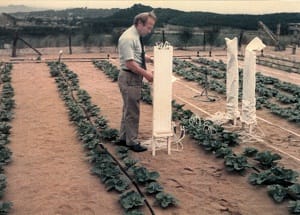Future of water demands innovation and conservation

 With water stresses already at high levels in many parts of the world and not expected to ease in 2013, a number of innovators are trying new technologies to produce, purify and conserve this critical resource.
With water stresses already at high levels in many parts of the world and not expected to ease in 2013, a number of innovators are trying new technologies to produce, purify and conserve this critical resource.
New solutions will be needed across the globe. The central US, for example, which experienced withering drought through 2012, is likely to see continued drier-than-average conditions in the months ahead, according to the latest outlook from the National Oceanic and Atmospheric Administration (NOAA).
While places like California and even Texas are exploring the potential to generate more fresh water for drinking and agriculture from desalination, conservation is viewed as a key strategy. By 2060, for example, conservation strategies are expected to help meet 24 percent of Texas’ water needs.
Among the conservation strategies recommended for water-stressed farmlands: flow-meters and rain gauges to measure irrigation and rainfall levels, growing more drought-resistant crops like dry-land sorghum and sunflower, leveling farmland and preventing runoff.
Educating farmers on such strategies is an important part of achieving conservation goals. The Texas Project for Ag Water Efficiency, for instance, offers hands-on workshops on low-cost, more efficient ways to irrigate.
Just getting water out of the ground to irrigate crops is difficult when wells must be dug ever-deeper to reach aquifers. In New Mexico, Tom Jenkins, an engineering professor at New Mexico State University, has developed a computerized system to help farmers and ranchers turn to solar power for their pumping needs.
Jenkins’ Solar Water Pumping Design Specification Spreadsheet is designed to calculate how big a solar-energy system a farm or ranch needs, and how much such a system could cost.
When irrigation water is available, it’s becoming increasingly important to measure and meter it to ensure it’s used efficiently.
“Interestingly, as important as irrigation is in the Texas High Plains, the use of metering technology to monitor irrigation water application has been limited,” notes a report from the Texas Alliance for Water Conservation. “Much like the GPS systems that reduce overlap in the application of chemicals, water meters could allow irrigated producers to better match inputs such as fertilizer and chemicals with irrigation system capabilities. If these inputs are better matched with irrigation levels, producers could see an economic benefit from better management of their irrigation water.”
Other innovative strategies — such as the micro-irrigation technique pioneered by 2012 World Food Prize Laureate Daniel Hillel — are especially needed in fast-growing, water- and climate-stressed regions like India and China.
Better use of so-called “big data” also enters into the picture.
“Many of the challenges … are highly interconnected,” noted a recent report on “agricultural preparedness” from President Barack Obama’s Council of Advisors on Science and Technology. “For example, addressing water use in agriculture should not be done independently of considering water quality and the efficient use of fertilizers and pesticides. Research on new pests and pathogens must simultaneously consider the impacts of a changing climate. As the agricultural research enterprise tackles these challenges, there
will be a greater need for integration and synthesis.”
The report continued, “Modern technology allows for the collection and use of many different types of agricultural data, from soil moisture and chemistry, meteorology and market conditions, crop and market conditions, consumer nutrition and preference, to gene sequences and ecological variables. Data sets in many of these fields are massive, which presents challenges for accessibility, interoperability, and persistence. As research efforts proceed, there will be a need for better data-management strategies addressing such issues as data storage, search algorithms, analytical methods, data sharing, and data visualization.”
Among some of the companies exploring opportunities in more efficient use of water for agriculture and underdeveloped regions are:
- Voltea – Named one of the World Economic Forum’s Technology Pioneers for 2013, this Dutch company has developed a technology it says can desalinate water more efficiently than reverse osmosis. Following a €1.2 million order from the Dutch Ministry of Infrastructure and the Environment, Voltea is building a full-scale treatment facility near Delft to desalinate wastewater for use in local greenhouse irrigation.
- Memstill – Developed by Dutch researcher Albert Jansen, the Memstill is a membrane distillation-based desalination technology that’s been tested in the Netherlands and Singapore.
- Aqua Sciences – Aqua Sciences’ technology, which draws evaporated moisture out of air to generate fresh water, has demonstrated in the field in both Saudi Arabia and in Haiti following the deadly earthquake in January 2010. The company is based in Florida.
- DloHaiti – A joint venture led by entrepreneurs and investors from Haiti and Silicon Valley, DloHaiti is described as a “market-based solution providing safe drinking water in Haiti at a price average Haitians can afford.” The business, which offers five-gallon jugs of water through local kiosks, plans to launch a pilot in Haiti starting early this year.
- Jompy – A unique water boiler, the Jompy can be used by campers as well as by people who need to boil water to ensure it’s safe to drink. Developed by Scotsman David Osborne, the Jompy uses metal tubing coiled into a disk shape to circulate and boil water over a fire that is also being used for cooking at the same time. Tested in Uganda, the device was found to reduce the risks of water-borne diseases and improve indoor air conditions due to a reduced need for cooking fuel.




